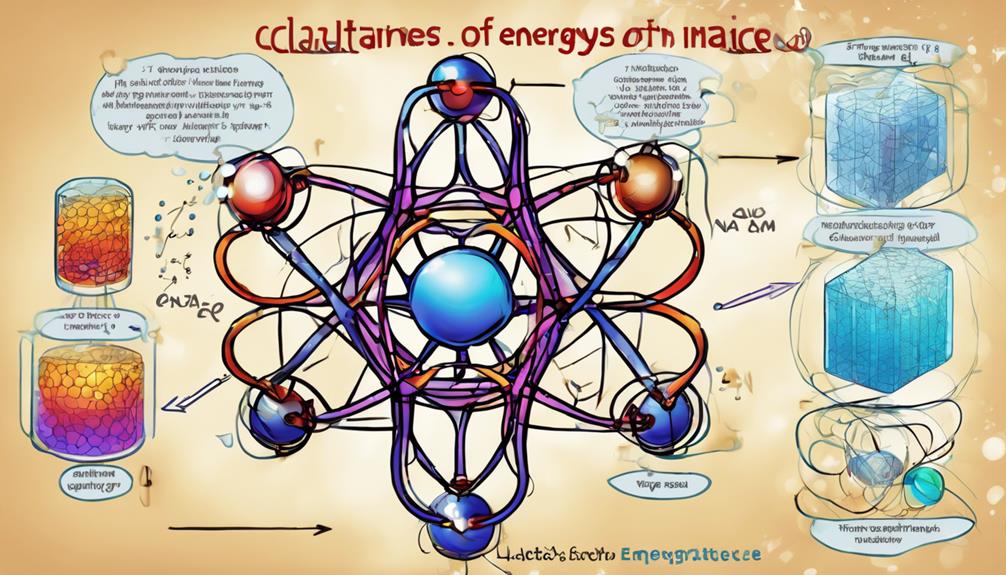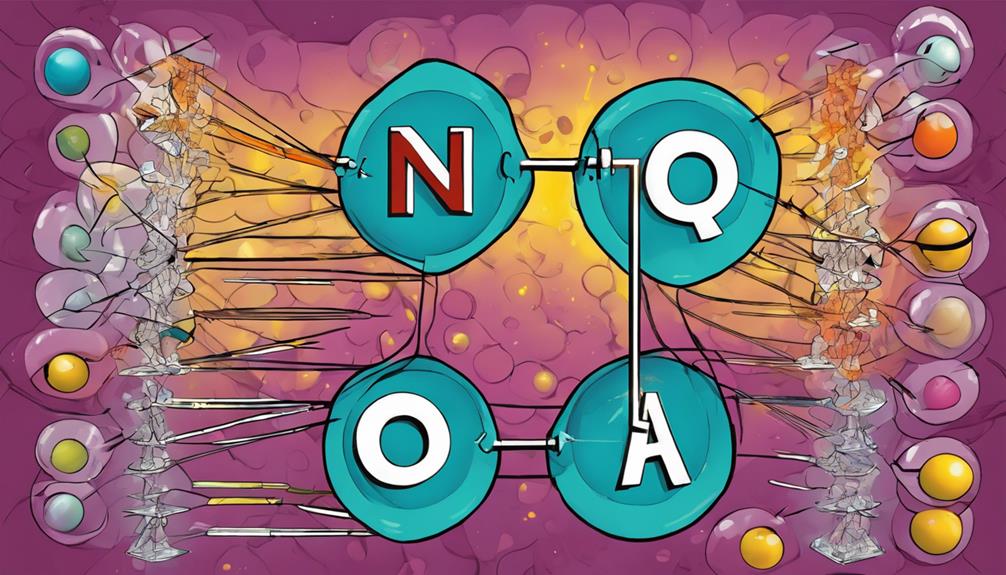To calculate the lattice energy of Na2O, determine sodium sublimation and ionization energies, then calculate oxygen dissociation energy. Apply Born-Haber cycle principles for the final value. Sublimation energy for 2 Na atoms is 218 kJ/mol, and ionization energy for 2 Na atoms is 990 kJ/mol. Understanding these steps will lead you to the precise lattice energy of Na2O.
Key Takeaways
- Calculate sublimation energy of sodium and ionization energy.
- Determine dissociation energy of oxygen for accurate lattice energy.
- Utilize Born-Haber cycle for Na2O lattice energy calculation.
- Consider missing data impact on lattice energy accuracy.
- Apply energy values in Hess's Law for precise results.
Calculation Steps for Na2O Lattice Energy
To calculate the lattice energy of Na2O, you need to accurately determine the sublimation energy of sodium and the dissociation energy of oxygen in the Born-Haber cycle. The process involves several vital steps.
First, the sublimation energy of sodium is the energy required to convert solid sodium into gaseous sodium atoms.
Second, the ionization energy of sodium is the energy needed to remove an electron from a sodium atom to form a sodium ion.
Third, the dissociation energy of oxygen is the energy required to break the O2 molecule into individual oxygen atoms.
By considering these values in the Born-Haber cycle, you can calculate the lattice energy of Na2O. This lattice energy represents the energy released when gaseous sodium cations and oxide anions combine to form the solid Na2O compound.
Missing Data Issue

The absence of the oxygen dissociation energy poses a significant obstacle in accurately determining the lattice energy of Na2O. Without this vital piece of data, a precise calculation of the lattice energy using the Born-Haber cycle becomes challenging. To showcase the impact of missing data, consider the following table:
| Energy Value | Importance in Calculation | Effect of Missing Data |
|---|---|---|
| Na+ ionization energy | Necessary for enthalpy change calculation | Incomplete Born-Haber cycle |
| O2 dissociation energy | Critical for accurate lattice energy determination | Hindered precise calculation |
| Na2O formation energy | Key to final numerical answer | Prevents obtaining accurate lattice energy |
Final Answer for Na2O Lattice Energy

The absence of the oxygen release energy presents a pivotal challenge when determining the final answer for the lattice energy of Na2O.
In the calculation of Na2O lattice energy using the Born-Haber cycle, various energy components such as sublimation energy, ionization energy, and formation energy are considered. However, the dissociation energy of oxygen is essential for an accurate determination of the lattice energy.
The lattice energy equation combines these energy components to calculate the overall energy change in the formation of Na2O. Hess's Law can be applied to summarize the individual energy contributions and arrive at the lattice energy value.
To obtain a precise result for Na2O lattice energy, it's crucial to have all the relevant energy values available to complete the calculation accurately.
Explanation of Calculation

Understanding how the lattice energy of Na2O is calculated involves considering various energy components and steps in the formation process. The calculation utilizes the Born-Haber cycle and key energy values such as ionization energy, electron affinity, and bond energy. By breaking down the formation of Na2O into these steps, the lattice energy can be estimated to be around 2122 kJ/mol. This process helps in determining the stability and properties of ionic compounds like Na2O. Below is a table highlighting the energy components involved in calculating the lattice energy of Na2O:
| Energy Component | Description |
|---|---|
| Ionization Energy | Energy required to remove an electron from sodium ions. |
| Electron Affinity | Energy released when oxygen gains an electron to form oxide ions. |
| Formation Energy | Energy change when sodium oxide is formed from its constituent ions. |
| Bond Energy | Energy needed to break and form bonds during the compound's formation. |
| Lattice Energy | Energy released when 1 mole of Na2O is formed in the gas phase. |
Alternate Calculation for Na2O Lattice Energy

For a simplified approach to determining the lattice energy of Na2O, consider summing the sublimation energy of sodium atoms and their ionization energy.
By using this alternate calculation method, you can accurately determine the total energy required for the formation of Na2O.
The sublimation energy for 2 Na atoms amounts to 218 kJ/mol, while the ionization energy for these 2 Na atoms is 990 kJ/mol.
When combined, these energy components yield a total of 1208 kJ/mol for the lattice energy of Na2O.
This simplified method directly accounts for the energies associated with sublimation and ionization of sodium, streamlining the process of calculating the lattice energy.
Understanding the individual energy contributions aids in achieving a more precise evaluation of the overall lattice energy of Na2O, providing a clear and efficient way to determine this important chemical property.
Frequently Asked Questions
How Is Lattice Energy Calculated?
To calculate lattice energy, consider energy changes in the formation of ionic compounds. Include ionization energy and electron affinity. Utilize the Born-Haber cycle and Hess's Law for accurate results. Combine relevant energy values to determine the lattice energy effectively.
How Do You Calculate Lattice Energy in Mgo?
To calculate lattice energy in MgO, you consider multiple steps like sublimation of magnesium and formation of MgO. Key values like ionization energy of Mg and electron affinity of O are essential in the process.
What Is the Lattice Energy of Naf?
You feel the bond's power as NaF's lattice energy dances at around -923 kJ/mol, a tribute to ions embracing in a solid's embrace. Charges and sizes sway this energetic waltz.
How Do You Calculate Lattice Energy on a Calculator?
To calculate lattice energy on a calculator, input the relevant energy terms like ionization energy and electron affinity. Use the Born-Haber cycle to contemplate energy changes in forming the ionic compound.
What is the significance of calculating lattice energy in ionic compounds like Na2O?
In ionic compounds like Na2O, calculating the lattice energy is significant because it helps determine the stability and strength of the bond between the ions. The lattice energy of CaF2 is a crucial factor in understanding the overall energy changes involved in the formation of the compound.
Conclusion
Calculating the lattice energy of Na2O may seem complex, but with the right steps and data, it can be done successfully.
For example, by using the Born-Haber cycle and taking into account the ionization energy, electron affinity, and other factors, you can determine the lattice energy of Na2O.
Just remember to double check your calculations and consider all the variables for an accurate result.
Happy calculating!









